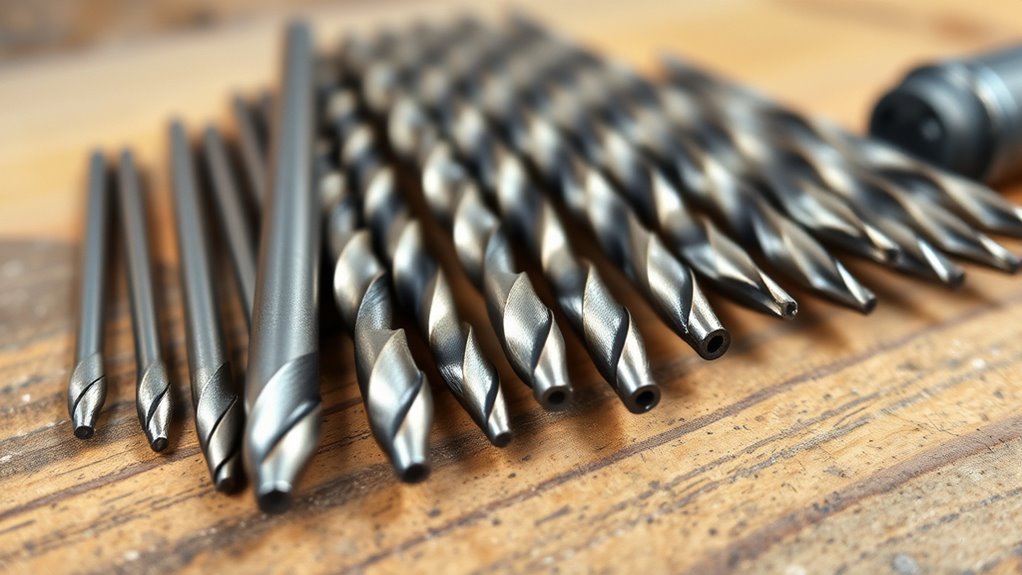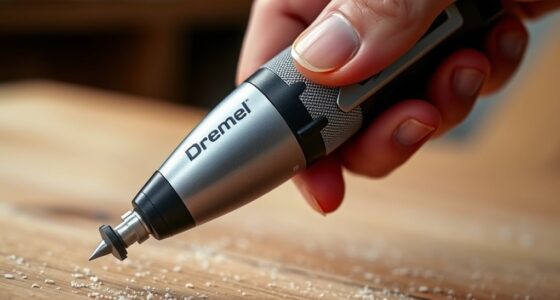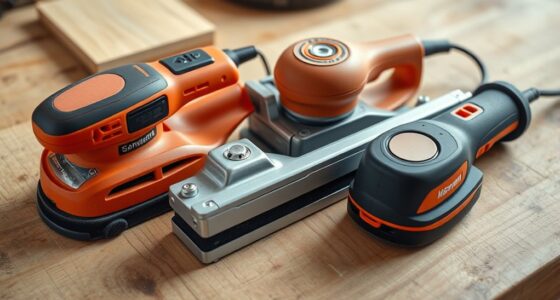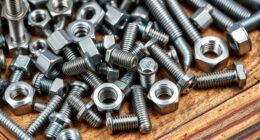Understanding drill bit sizes and materials helps you choose the right tool for each project. Correct sizing ensures precise holes and prevents damage, while matching the bit material to your material—like high-speed steel, cobalt, or carbide—improves performance and durability. Smaller bits are great for pilot holes, while larger ones handle heavy-duty tasks. Knowing how to select the proper size and material makes your drilling more efficient and successful. Keep exploring to learn more about perfecting your drill bit choices.
Key Takeaways
- Drill bit sizes vary from tiny pilot holes to large diameters, impacting hole quality and project success.
- Selecting the right size depends on the material and specific task requirements.
- Common drill bit materials include HSS, cobalt, carbide, and titanium-coated, each suited for different materials.
- Proper maintenance and sharpening extend drill bit lifespan and ensure precise, clean holes.
- Custom or specialized bits are available for high-performance or unique material applications.

Choosing the right drill bit starts with understanding its size and material, as these factors directly impact your project‘s success. When selecting a drill bit, consider the diameter needed for your specific task. Bits come in various sizes, from tiny pilot holes to large diameter bits for heavy-duty drilling. Using a bit that’s too small or too large can lead to poor results or damage to your workpiece. It’s essential to match the bit size to the material and the purpose of your project.
Choosing the right drill bit size is key to successful and damage-free drilling.
The material of the drill bit plays an essential role in its performance and durability. Common materials include high-speed steel (HSS), cobalt, carbide, and titanium-coated bits. HSS bits are versatile and suitable for most wood and soft metal applications, but they may wear out faster when used on harder materials. Cobalt bits are more heat-resistant and last longer when drilling into stainless steel or other tough metals. Carbide bits are extremely durable and perfect for drilling into hard materials like tile, stone, or hardened steel, but they’re also more brittle. Titanium-coated bits offer enhanced hardness and reduced friction, making them ideal for frequent use with softer materials.
Understanding drill bit sharpening techniques can extend your bits’ lifespan and improve cutting performance. Over time, bits become dull, leading to increased effort and potential damage to your workpiece. Proper drill bit sharpening guarantees clean, precise holes and can save you money by avoiding frequent replacements. If you’re skilled, you might consider sharpening your bits yourself with a grinding stone or specialized sharpening tool. Otherwise, professional sharpening services or custom drill bit manufacturing can be valuable options. Custom manufacturing allows for tailored bits designed for specific materials or high-performance needs, and these often come sharpened and ready to use, saving you time and effort. Additionally, selecting the appropriate drill bit type for your project ensures optimal results and efficiency.
Frequently Asked Questions
How Do I Choose the Right Drill Bit for Delicate Materials?
To select the right drill bit for delicate materials, you should prioritize material compatibility and precision drilling. Use bits made of softer materials like high-speed steel or brad point bits designed for gentle cuts. These ensure clean, accurate holes without damaging your workpiece. Always match the bit to your material’s fragility, and drill slowly to maintain control. This approach helps preserve delicate surfaces while achieving professional results.
Are There Eco-Friendly or Biodegradable Drill Bits Available?
You might think eco-friendly or biodegradable drill bits are rare, but they’re actually gaining popularity. Researchers are exploring eco-friendly materials like bioplastics and recycled metals to create sustainable options. While these biodegradable options are still emerging, they offer a greener alternative to traditional bits. By choosing drill bits made from eco-friendly materials, you help reduce environmental impact, making your projects more sustainable without sacrificing performance.
How Do Temperature Changes Affect Drill Bit Performance?
Temperature changes can markedly impact your drill bit’s performance. As it heats up, thermal expansion causes the bit to slightly enlarge, which can reduce precision. Conversely, cooling can make the material harder and more brittle, increasing the risk of breakage. You should monitor temperature during use, as extreme heat can degrade the bit’s hardness and efficiency, ultimately affecting your drilling accuracy and safety.
Can Drill Bits Be Sharpened or Reconditioned?
You might find that drill bits can indeed be sharpened or reconditioned, extending their lifespan. The reconditioning process involves sharpening techniques that remove dull edges and restore cutting efficiency. By carefully re-sharpening your drill bits, you ensure cleaner holes and less strain on your tools. This simple maintenance step saves you money and keeps your work precise, making it a wise choice for any DIY or professional project.
What Safety Precautions Should I Follow When Using Different Drill Bit Materials?
When using different drill bit materials, you should prioritize workspace safety and wear proper personal protective equipment, like goggles and gloves. Always handle bits carefully to avoid injury, and guarantee your workspace is well-ventilated and free of clutter. Make sure to use the right bit for the material you’re drilling into, and follow manufacturer guidelines to prevent accidents. Staying alert and cautious keeps you safe during drilling tasks.
Conclusion
So, now you’re a drill bit expert, armed with sizes and materials that’ll make you look like a DIY genius—until you realize you still forgot to wear safety goggles. But hey, at least you know which bit to use, even if your project ends up a little crooked. Just remember, whether it’s steel or wood, choosing the right bit is your secret weapon—until you drill through your finger, then it’s just a lesson in humility.









